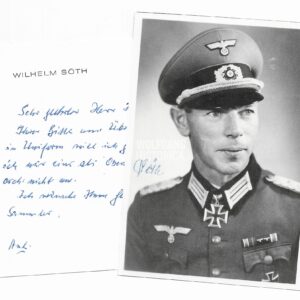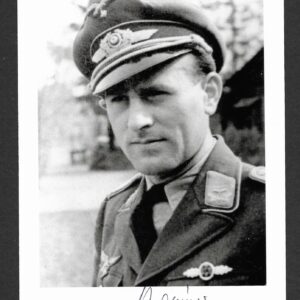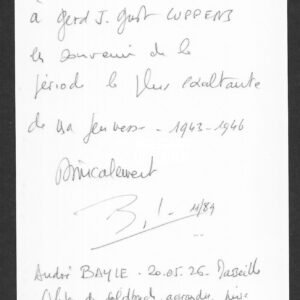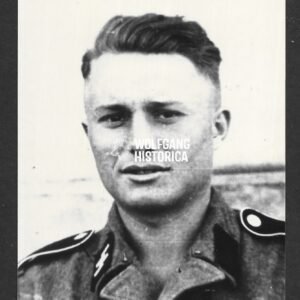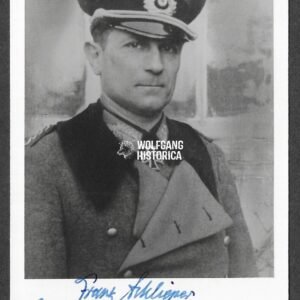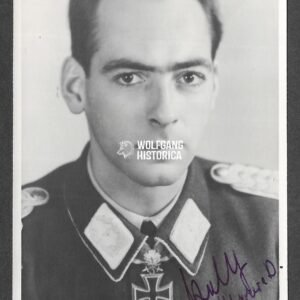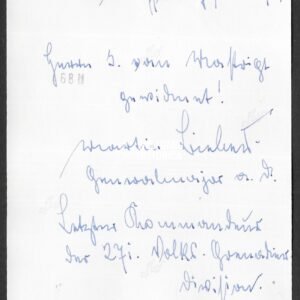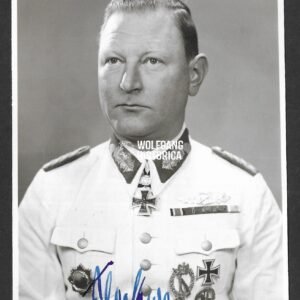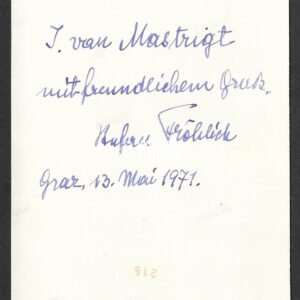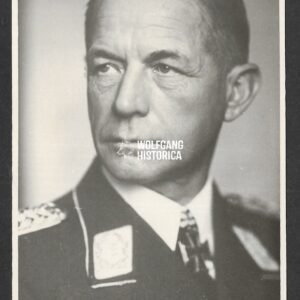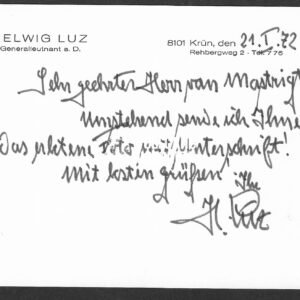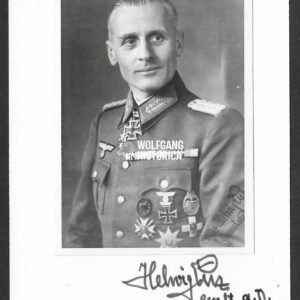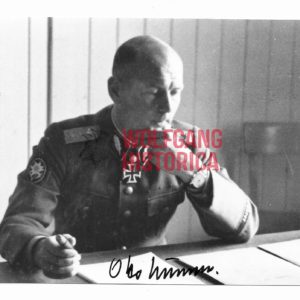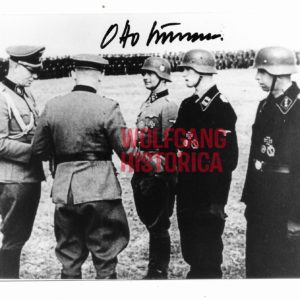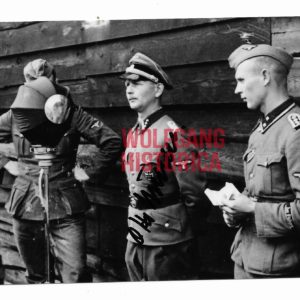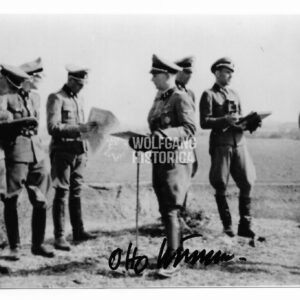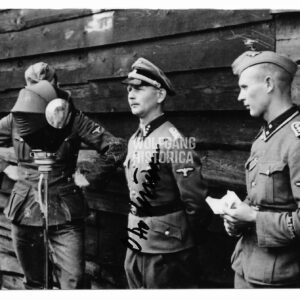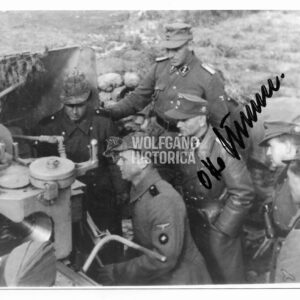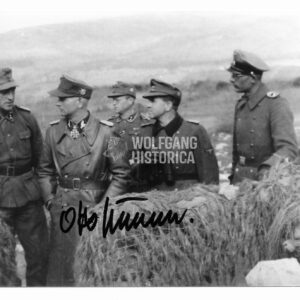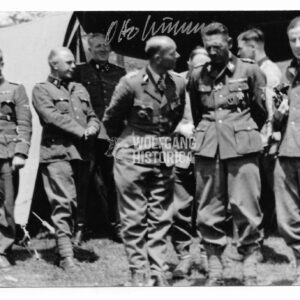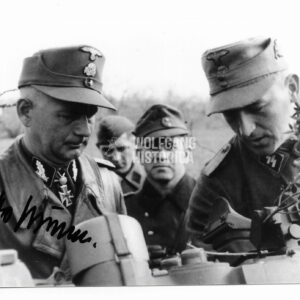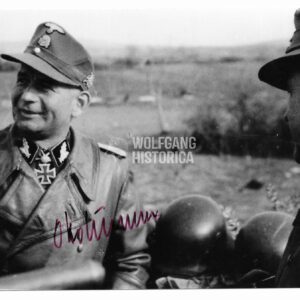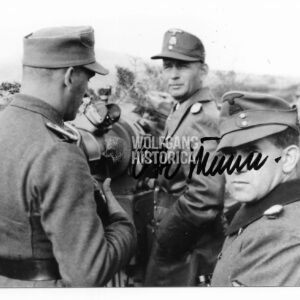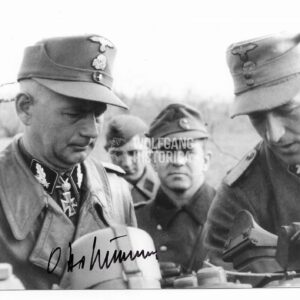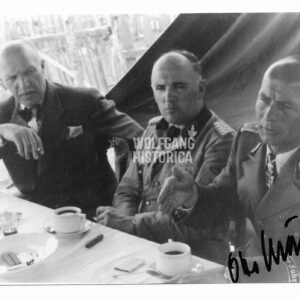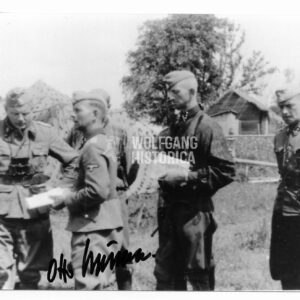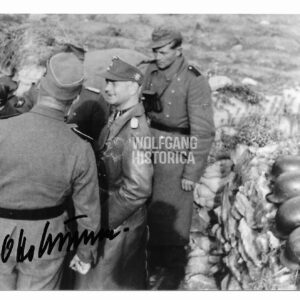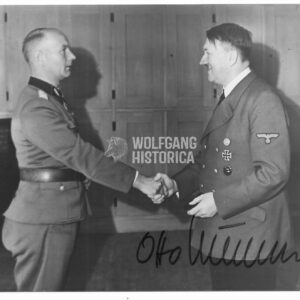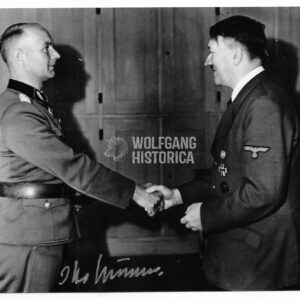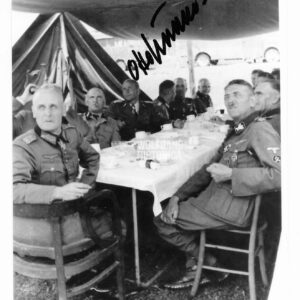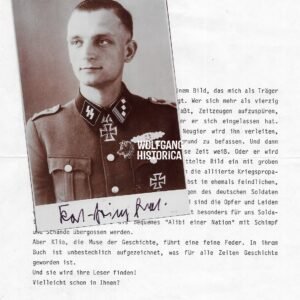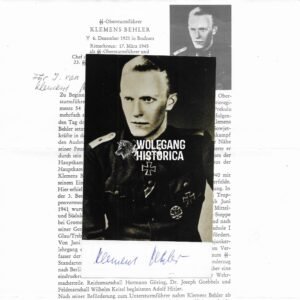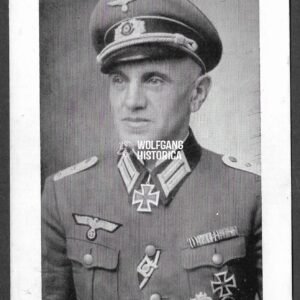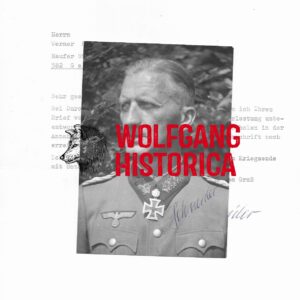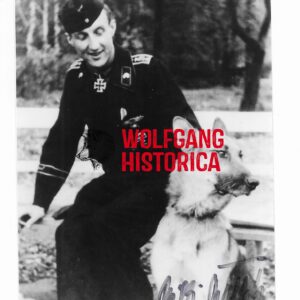Wilhelm Söth – Artillerie-Regiment 56 (1. Panzer-Division)
€65,00Gerhard Lindner – 346. Infanterie-Division (Generalmajor, Arnhem)
€65,00Anton Benning – Jagdgeschwader 301 (Stalingrad & 28 Victories!)
€65,00Hans Siegel – SS-Panzer-Regiment 12 “Hitlerjugend” (Normandy)
€65,00André Bayle – 33. Waffen-Grenadier-Division der SS “Charlemagne” (French Volunteer)
€65,00Franz Schlieper – Grenadier-Regiment 94 & Grenadier-Regiment 1132
€65,00Original Postwar Signature on a Postwar Photo of Franz Schlieper. Generalmajor Franz Schlieper (22 August 1905 † 4 April 1974) was a career officer in the German Army during the Second World War who rose to divisional command. He was decorated with both the German Cross in Gold and the Knight’s Cross of the Iron Cross for his battlefield leadership.
Awards and Decorations:
-
German Cross in Gold (Deutsches Kreuz in Gold) – 10 January 1944, as Oberst and Kommandeur of Grenadier-Regiment 94, 32. Infanterie-Division (Heer).
-
Knight’s Cross of the Iron Cross (Ritterkreuz des Eisernen Kreuzes) – 21 September 1944, as Oberst and Kommandeur of Grenadier-Brigade 1132, Führer of the 73. Infanterie-Division (Heer).
Career Highlights:
-
Entered the Reichswehr as a young officer and advanced steadily through the interwar years.
-
Distinguished himself as regimental commander with the 32. Infanterie-Division, earning the German Cross in Gold during the heavy fighting on the Eastern Front.
-
Promoted to brigade and divisional command, he received the Knight’s Cross in late 1944 for his leadership of Grenadier-Brigade 1132 and acting command of the 73. Infanterie-Division.
-
Captured by Soviet forces in May 1945 and held in captivity until 1955.
-
Returned to Germany after release and lived there until his death in 1974.
Item Details:
-
Authentic postwar signature of Franz Schlieper.
-
Signed on a postwar photograph.
-
Condition: Excellent preserved example, with clear autograph.
Karl Bodenschatz – Liaison Officer between Hermann Göring & Adolf Hitler (Wounded on July 20, 1944)
€65,00Original Postwar Signature on the Reverse of an Wartime Postcard of Karl-Heinrich Bodenschatz. General der Flieger Karl-Heinrich Bodenschatz (10 December 1890, Rehau † 25 August 1979, Erlangen) was a German general and veteran of both World Wars. In the First World War he served as adjutant to the famous “Red Baron,” Manfred von Richthofen. During the Second World War, Bodenschatz became the liaison officer between Hermann Göring and Adolf Hitler, serving at the highest levels of the Third Reich’s military command.
On 20 July 1944, while serving at Hitler’s headquarters, Bodenschatz was gravely wounded in the assassination attempt at the Wolf’s Lair in Rastenburg. He received the 20. Juli 1944 Wound Badge in Gold, one of the rarest decorations of the war, awarded only to those injured in the failed plot. Bodenschatz was fortunate to survive, as officers immediately to his left and right were killed by the blast.
Item Details:
-
Authentic postwar signature of General der Flieger Karl-Heinrich Bodenschatz.
-
Signature is located on the reverse of an original wartime postcard.
-
Condition: Clear autograph on reverse; postcard well-preserved.
Collector’s Note:
As adjutant to the legendary Red Baron in WWI and later liaison between Göring and Hitler in WWII, Bodenschatz represents a unique bridge between Germany’s two great conflicts. His survival of the 20 July plot and the award of the extremely rare Gold Wound Badge (20. Juli 1944) make his signed material highly sought after. This example, signed on the reverse of an original wartime postcard, adds further desirability for serious collectors of Luftwaffe and high-command memorabilia.
Dietrich Peltz – Sturzkampfgeschwader 77 (Schwertern)
€65,00Original Postwar Signature on a Postwar Photo of Dietrich Peltz. Generalmajor Dietrich Peltz (6 September 1914, Gießen † 10 August 2001, Munich) was one of the Luftwaffe’s most decorated bomber officers, rising to the rank of Generalmajor and earning the Knight’s Cross of the Iron Cross with Oak Leaves and Swords. Recognized for his aggressive leadership in dive-bomber operations and later as a planner of strategic bombing raids, he became one of the youngest generals in the German armed forces.
Awards and Decorations:
-
Knight’s Cross of the Iron Cross (Ritterkreuz des Eisernen Kreuzes) – 14 October 1940, as Oberleutnant with the Stab of Sturzkampfgeschwader 77.
-
Oak Leaves to the Knight’s Cross (Eichenlaub zum Ritterkreuz des Eisernen Kreuzes, 53rd award) – 31 December 1941, as Hauptmann and Kommandeur of II./ Sturzkampfgeschwader 77.
-
Swords to the Knight’s Cross with Oak Leaves (Schwerter zum Ritterkreuz des Eisernen Kreuzes, 33rd award) – July 1943, as Oberst im Generalstab and Angriffsführer England.
Career Highlights:
-
Distinguished himself as a Stuka pilot and commander in the early campaigns, earning the Knight’s Cross in 1940.
-
As Kommandeur of II./StG 77, led his group in intensive dive-bombing operations on the Eastern Front, where his effectiveness was recognized with the Oak Leaves in 1941.
-
Later transferred to the Luftwaffe General Staff, becoming Angriffsführer England, tasked with planning and executing bomber raids against Britain in 1943, which earned him the Swords.
-
Promoted rapidly due to his ability, he was one of the youngest officers to reach the rank of Generalmajor.
-
Survived the war, later living in Munich until his death in 2001.
Item Details:
-
Authentic postwar signature of Generalmajor Dietrich Peltz.
-
Signed on a postwar photograph.
-
Condition: Clear and well-preserved autograph.
Collector’s Note:
Peltz’s combination of frontline combat command with Stuka units and his later role as a strategic bombing planner make him an especially interesting figure. His awards — the Knight’s Cross with Oak Leaves and Swords — place him among the most highly decorated Luftwaffe officers, making his signed photo a desirable addition for collectors of decorated bomber leaders and high-ranking Luftwaffe personalities.
Martin Bieber – Grenadier-Regiment 184 & Divisionsgruppe 86 (Eichenlaub)
€65,00Original Postwar Signature on a Postwar Photo of Martin Bieber. Generalleutnant Martin Bieber (17 November 1900, Tabarz † 19 October 1974, Bad Reichenhall) was a German Army officer who rose to the rank of Generalleutnant during the Second World War. He distinguished himself as a regimental and divisional commander on the Eastern Front and was decorated with the Knight’s Cross of the Iron Cross with Oak Leaves for his leadership.
Awards and Decorations:
-
Knight’s Cross of the Iron Cross (Ritterkreuz des Eisernen Kreuzes, 1901st award) – 28 July 1943, as Oberst and Kommandeur of Grenadier-Regiment 184, 86. Infanterie-Division, XXXXI. Panzer-Korps, 9. Armee, Heeresgruppe Mitte.
-
Oak Leaves to the Knight’s Cross (Ritterkreuz mit Eichenlaub, 601st award) – 2 September 1944, as Oberst and Führer of Divisionsgruppe 86, Korps-Abteilung E, XX. Armeekorps, 2. Armee, Heeresgruppe Mitte.
Career Highlights:
-
Career officer from the Reichswehr era who served with distinction throughout WWII.
-
As commander of Grenadier-Regiment 184, he earned the Knight’s Cross in 1943 during the heavy fighting on the central sector of the Eastern Front.
-
Promoted to divisional leadership, taking over Divisionsgruppe 86, later absorbed into Korps-Abteilung E, where he proved his resilience during the defensive battles of 1944.
-
Awarded the Oak Leaves in September 1944 for his skillful leadership of these ad-hoc formations under extreme pressure during the Soviet summer offensives.
-
Promoted to Generalleutnant before the end of the war, surviving captivity and later settling in Bavaria.
- Commander of 271. Volksgrenadier-Division.
Item Details:
-
Authentic postwar signature of Generalleutnant Martin Bieber.
-
Signed on a postwar photograph.
-
Condition: Clear and well-preserved autograph.
Hermann Niehoff – 371. Infanterie-Division (Eichenlaub)
€65,00Original Postwar Signature on a Postwar Photo of Hermann Niehoff. General der Infanterie Hermann Niehoff (3 April 1897, Papenburg † 5 November 1980, Riegsee) was a career officer of the German Army who rose to the rank of General der Infanterie during the Second World War. He distinguished himself as a regimental and divisional commander on the Eastern Front, earning the Knight’s Cross with Oak Leaves. In the final days of the war, he became the last commander of the German fortress of Breslau.
Awards and Decorations:
-
Ehrenblattspange des Heeres und Waffen-SS – 29 September 1941, as Oberstleutnant and Kommandeur of Infanterie-Regiment 464, 253. Infanterie-Division. (366th award)
-
German Cross in Gold (Deutsches Kreuz in Gold) – 6 January 1942, as Oberstleutnant and Kommandeur of Infanterie-Regiment 464, 253. Infanterie-Division. (Award 46/11)
-
Knight’s Cross of the Iron Cross (Ritterkreuz des Eisernen Kreuzes, 3143rd award) – 15 June 1944, as Generalleutnant and Kommandeur of the 371. Infanterie-Division.
Awarded for his Division’s successful withdrawal actions and subsequent defense along the Bug river in March 1944, where Niehoff’s personal energy and determination were crucial to preventing a Soviet breakthrough.
-
Wehrmachtbericht Mention – 11 August 1944, as Generalleutnant and Kommandeur of 371. Infanterie-Division, noted for the Division’s performance on the Eastern Front.
-
Oak Leaves to the Knight’s Cross (Ritterkreuz mit Eichenlaub, 808th award) – 5 March 1945, as Generalleutnant and Kommandeur of the 371. Infanterie-Division, 17. Armee, Heeresgruppe Mitte.
In February 1945, Niehoff’s division repelled a major Soviet offensive near Ratibor, fighting tenaciously to hold open Reichsstraße 118 despite repeated assaults, some of which were fought off in close combat. His determined leadership earned him the Oak Leaves.
Career Highlights:
-
World War I veteran who rejoined the Reichswehr and steadily advanced during the interwar years.
-
On the Eastern Front, led Infanterie-Regiment 464 and later the 371. Infanterie-Division in some of the hardest fighting of the war.
-
Decorated with the Knight’s Cross and Oak Leaves for outstanding leadership during defensive battles in 1944–45.
-
In April 1945, appointed Kommandant of Breslau, one of the Reich’s last fortress cities, where he commanded until surrendering the city to the Red Army on 6 May 1945.
-
Survived Soviet captivity and was released in 1955. He lived in Bavaria until his death in 1980.
Item Details:
-
Authentic postwar signature of General der Infanterie Hermann Niehoff.
-
Signed on a postwar photograph.
-
Condition: Clear and well-preserved autograph.
Collector’s Note:
Niehoff’s significance lies both in his Knight’s Cross with Oak Leaves for frontline command and his role as the last Fortress Commander of Breslau, one of the most famous German Festungen of WWII. His autograph is highly sought after by collectors of high-ranking Heer generals, Eastern Front commanders, and those focusing on the final battles of 1945.
Wilhelm Bleckwenn – Grenadier-Regiment 487 (Eichenlaub)
€65,00Original Postwar Signature on a Postwar Photo of Wilhelm Bleckwenn. Generalmajor Wilhelm Bleckwenn (21 October 1906 † 10 May 1989) was a German Army officer who rose to the rank of Generalmajor during the Second World War. A front-line regimental commander, he earned both the Knight’s Cross of the Iron Cross and later the Oak Leaves for his leadership of Grenadier-Regiment 487 of the 267. Infanterie-Division.
Awards and Decorations:
-
Knight’s Cross of the Iron Cross (Ritterkreuz des Eisernen Kreuzes) – 6 April 1944, as Oberst and Kommandeur of Grenadier-Regiment 487, 267. Infanterie-Division.
-
Oak Leaves to the Knight’s Cross (Ritterkreuz mit Eichenlaub, 638th award) – 18 October 1944, as Oberst and Kommandeur of Grenadier-Regiment 487, 267. Infanterie-Division.
Oak Leaves Citation:
Following the collapse of Heeresgruppe Mitte during Operation Bagration, Oberst Bleckwenn and a small Kampfgruppe under his command managed to break through to East Prussia after 44 days of continuous fighting through the Belorussian forests. In one of the most notable actions of this retreat, on the night of 4/5 August 1944, Bleckwenn led his men across the Memel river south of Druschkiniki, overcoming torrential currents and enemy resistance. For this remarkable achievement of leadership and perseverance, he was awarded the Oak Leaves.
Career Highlights:
-
Career officer who served in both the Reichswehr and Wehrmacht.
-
Commanded Grenadier-Regiment 487 with distinction on the Eastern Front.
-
Decorated with the Knight’s Cross in April 1944 for earlier combat leadership.
-
Survived the war, later attaining the rank of Generalmajor.
-
Lived until 1989, passing away at the age of 82.
Item Details:
-
Authentic postwar signature of Generalmajor Wilhelm Bleckwenn.
-
Signed on a postwar photograph.
-
Condition: Good, with a clear and well-preserved autograph.
Collector’s Note:
Bleckwenn’s Oak Leaves citation highlights one of the most dramatic survival and retreat stories of 1944. His leadership during the collapse of Heeresgruppe Mitte and his regiment’s epic retreat into East Prussia makes his signature a highly desirable piece for Eastern Front collectors.
Stefan Fröhlich – Kampfgeschwader 76 & Fliegerführer Afrika
€65,00Original Postwar Signature on a Postwar Photo of Stefan Fröhlich. General der Flieger Stefan Fröhlich (7 October 1889, Orsova † 2 October 1978, Graz) was an Austrian-born officer who transferred to the Luftwaffe after the Anschluss and rose to the rank of General der Flieger during the Second World War. Beginning his career as an engineer officer in the Austro-Hungarian Army, he later trained as a pilot and transitioned into air force service, where he became one of the Luftwaffe’s experienced leaders.
Awards and Decorations:
-
Ritterkreuz des Eisernen Kreuzes – 4 July 1940, as Generalmajor und Kommodore of Kampfgeschwader 76.
-
Deutsches Kreuz in Gold – 11 May 1942, as Generalleutnant und Fliegerführer Afrika
Career Highlights:
-
Prewar: Officer of the Austro-Hungarian Army and later the Austrian Bundesheer, rising to Oberst and commanding air training schools before the Anschluss.
-
1939–1940: Kommodore of Kampfgeschwader 76, leading it in the campaigns in Poland and France, as well as during the early Battle of Britain.
-
1941: Appointed Fliegerführer Afrika, establishing close cooperation with General Rommel and coordinating Luftwaffe support during the North African campaign.
-
1942: Commanded 2. Flieger-Division on the Eastern Front; later promoted to General der Flieger and given command of IX. Fliegerkorps.
-
1943–1945: Commanded Luftgau XVII (Vienna), briefly led Luftwaffenkommando Südost, and finally served as Oberbefehlshaber of Luftflotte 10 in the last weeks of the war.
Item Details:
-
Authentic postwar signature of General der Flieger Stefan Fröhlich.
-
Signed on a postwar photograph.
-
Condition: Excellent, with a strong, legible autograph.
Collector’s Note:
General der Flieger Stefan Fröhlich stands out as one of the few Austrian officers to reach high rank in the Luftwaffe. Decorated with both the Knight’s Cross and the German Cross in Gold, his leadership spanned the Luftwaffe’s major theaters — from the skies over France to the deserts of North Africa and the Eastern Front. His signature is a desirable addition to any collection of Luftwaffe generals or decorated commanders of the air war.
Helwig Luz – Schützen-Regiment 110 (Son KIA in Stalingrad)
€65,00Original Postwar Signature on a Postwar Card with Photo of Helwig Luz. Generalleutnant Helwig Luz (28 June 1892 † 28 April 1980) was a German Army officer who rose to the rank of Generalleutnant during the Second World War. A highly experienced Panzer leader, he was decorated with the Knight’s Cross of the Iron Cross for his achievements with the 11. Panzer-Division.
Awards and Decorations:
-
Knight’s Cross of the Iron Cross (Ritterkreuz des Eisernen Kreuzes) – 15 November 1941, as Oberst and Kommandeur of Schützen-Regiment 110, 11. Panzer-Division.
Career Highlights:
-
Entered military service before the First World War, serving with distinction in both world wars.
-
Commanded Schützen-Regiment 110 of the renowned 11. Panzer-Division, where he earned the Knight’s Cross for his leadership on the Eastern Front in 1941.
-
In September 1942, his son Helwig Luz Jr., serving as a Leutnant with Panzer-Regiment 24, was killed in action at Stalingrad.
-
Shortly afterward, Luz was recalled to Germany and placed in the Führerreserve, before being assigned in February 1943 to lead the Settlement Office of the 6th Army (Abwicklungsstelle 6. Armee), responsible for administrative and personnel matters following the destruction of the army at Stalingrad.
-
Continued to serve in various posts until the end of the war, reaching the rank of Generalleutnant.
-
Survived the war and lived in Bavaria until his death in 1980.
Item Details:
-
Authentic postwar signature of Generalleutnant Helwig Luz.
-
Signed on a postwar photograph.
-
Condition: Good, clear autograph.
Collector’s Note:
Luz’s role as a decorated Panzer commander and later as head of the 6th Army’s settlement office after Stalingrad makes him a figure of historical importance. Combined with the personal tragedy of his son’s death at Stalingrad, his story reflects both the military and human dimensions of the war. His signed photo is a highly collectible piece for those interested in Panzer leaders and Knight’s Cross recipients of the Wehrmacht.
Otto Kumm – Regiment “Der Führer” & Division “Prinz Eugen” (Swords)
€70,00Otto Kumm – Regiment “Der Führer” & Division “Prinz Eugen” (Swords)
€70,00Otto Kumm – Regiment “Der Führer” & Division “Prinz Eugen” (Swords)
€70,00Otto Kumm – Regiment “Der Führer” & Division “Prinz Eugen”
€70,00Original Postwar Signature on a Postwar Photo of Otto Kumm. SS-Brigadeführer Otto Kumm (01.10.1909 † 23.03.2004) earned the Ritterkreuz on February 16, 1942 as SS-Obersturmbannführer und Kommandeur of the SS-Infanterie-Regiment “Der Führer”, the Eichenlaub on April 6, 1943 as SS-Obersturmbannführer und Kommandeur of the SS-Panzer-Grenadier-Regiment 4 “Der Führer” of the 2. SS-Panzer-Division “Das Reich“ and the Schwertern on March 17, 1945 as SS-Brigadeführer und Kommandeur of 7. SS-Freiwilligen-Gebirgs-Division “Prinz Eugen”.
Read more on Otto Kumm (Wikipedia)
Otto Kumm – Regiment “Der Führer” & Division “Prinz Eugen” (Schwertern)
€70,00Otto Kumm – Regiment “Der Führer” & Division “Prinz Eugen” (Schwertern)
€70,00Otto Kumm – Regiment “Der Führer” & Division “Prinz Eugen” (Schwertern)
€70,00Otto Kumm – Regiment “Der Führer” & Division “Prinz Eugen” (Schwertern)
€70,00Otto Kumm – Regiment “Der Führer” & Division “Prinz Eugen” (Schwertern)
€70,00Otto Kumm – Regiment “Der Führer” & Division “Prinz Eugen” (Schwertern)
€70,00Otto Kumm – Regiment “Der Führer” & Division “Prinz Eugen” (Schwertern)
€70,00Otto Kumm – Regiment “Der Führer” & Division “Prinz Eugen” (Schwertern)
€70,00Otto Kumm – Regiment “Der Führer” & Division “Prinz Eugen” (Schwertern)
€70,00Otto Kumm – Regiment “Der Führer” & Division “Prinz Eugen” (Schwertern)
€70,00Otto Kumm – Regiment “Der Führer” & Division “Prinz Eugen” (Schwertern)
€70,00Otto Kumm – Regiment “Der Führer” & Division “Prinz Eugen” (Schwertern)
€70,00Otto Kumm – Regiment “Der Führer” & Division “Prinz Eugen” (Schwertern)
€70,00Otto Kumm – Regiment “Der Führer” & Division “Prinz Eugen” (Schwertern)
€70,00Otto Kumm – Regiment “Der Führer” & Division “Prinz Eugen” (Schwertern)
€70,00Otto Kumm – Regiment “Der Führer” & Division “Prinz Eugen” (Schwertern)
€70,00Otto Kumm – Regiment “Der Führer” & Division “Prinz Eugen” (Schwertern)
€70,00Otto Kumm – Regiment “Der Führer” & Division “Prinz Eugen” (Schwertern)
€70,00Otto Kumm – Regiment “Der Führer” & Division “Prinz Eugen” (Schwertern)
€70,00Otto Kumm – Regiment “Der Führer” & Division “Prinz Eugen” (Schwertern)
€70,00Otto Kumm – Regiment “Der Führer” & Division “Prinz Eugen” (Schwertern)
€70,00Otto Kumm – Regiment “Der Führer” & Division “Prinz Eugen” (Schwertern)
€70,00Karl-Heinz Ertel – SS-Panzer-Grenadier-Regiment 49 “De Ruyter” (“Nederland” Division)
€70,00Original Postwar Signature on a Postwar Photo of Karl-Heinz Ertel. SS-Hauptsturmführer Karl-Heinz Ertel (26.11.1919 in Brambauer † 25.01.1993 in Langenberg) earned the Ritterkreuz des Eisernen Kreuzes on August 23, 1944 as SS-Hauptsturmführer und Adjutant of the SS-Panzer-Grenadier-Regiment 49 “De Ruyter” of the SS-Freiwilligen-Panzer-Grenadier-Brigade “Nederland”. Comes with extra signed letter.
Ritterkreuz: “Following heavy retreat battles, on the night of the 25./26.07.1944 the Tannenberg Line between Orphanage Hill and the Gulf of Finland was occupied by the Regiment 49 ‘De Ruyter’. The Regiment had the mission of holding this line against all enemy attacks. The enemy commenced an immediate assault with a much greater number of divisions, which were aided by strong tank, artillery and air support. In a sacrificial battle, the Regiment succeeded in defeating all enemy attacks with extremely high losses for the foe. In this major struggle the commander of the Regiment, SS-Obersturmbannführer Collani, fell in battle. In this moment of crisis his adjutant, SS-Hauptsturmführer Ertel, took over leadership of the Regiment. Undeterred by the strong enemy fire from tanks, rocket launchers, artillery and aircraft, he repeatedly went to the hotspots of the fighting. From these points he inspired officers, NCOs and men to offer up their greatest possible resistance via his own exemplary behaviour. Even after being wounded by a shell splinter to the face he remained with the Regiment and maintained a firm grip over its command. His crisis-proof, exemplary attitude was of immeasurable value to the Brigade in the hours of its greatest test on the battlefield. He significantly contributed to the prevention of the intended enemy breakthrough against Reval.”Klemens Behler – 23. SS-Freiwilligen-Panzergrenadier-Division “Nederland”
€70,00Franz Ketterl – Infanterie-Regiment 438 (132. Infanterie-Division) (Wartime Signed)
€70,00Original Wartime Signature on a Postcard of Franz Ketterl. Oberleutnant Franz Ketterl
(21 March 1898 – 27 July 1979) was a German Army officer who served on the Eastern Front during the Second World War. As company commander of 1./Infanterie-Regiment 438, 132. Infanterie-Division, he distinguished himself in heavy winter fighting and received the Knight’s Cross of the Iron Cross on 12 January 1942 for his leadership and bravery.
Awards and Decorations
- Knight’s Cross of the Iron Cross (Ritterkreuz des Eisernen Kreuzes) – 12 January 1942, as Oberleutnant and Chef of 1./Infanterie-Regiment 438, 132. Infanterie-Division.
Career Highlights
-
Served in the 132. Infanterie-Division, which fought extensively on the Eastern Front from 1941 onward.
-
As company commander of 1./Infanterie-Regiment 438, Ketterl played a key role in the division’s bitter engagements during the early stages of the Soviet campaign.
-
Awarded the Ritterkreuz for his personal bravery and leadership in combat during the severe winter fighting of 1941/42.
-
Survived the war and lived until 1979.
Item Details
-
Authentic wartime signature of Oberleutnant Franz Ketterl.
-
Signed on a wartime postcard.
-
Condition: Largely faded, as seen.
Collector’s Note
Franz Ketterl represents the many front-line company commanders who bore the brunt of the brutal Eastern Front battles. His award of the Knight’s Cross in early 1942, during the desperate winter fighting, reflects the importance of small-unit leadership at a critical time in the German campaign. A rare and historically significant autograph for collectors of Ritterkreuz recipients and Eastern Front memorabilia.
Friedrich Wiese – Infanterie-Regiment 38 & XXXV. Armeekorps (Oakleaves)
€75,00Erich Schneider – 4. Panzer-Division & 14. Infanterie-Division (Eichenlaub)
€75,00Original Postwar Signature on a Postwar Photo plus Letter of Erich Schneider. Generalleutnant Erich Schneider (12.08.1894 † 03.08.1980) earned the Ritterkreuz on May 5, 1943 as Generalmajor und Kommandeur of the 4. Panzer-Division and the Eichenlaub on March 6, 1945 as Generalleutnant und Kommandeur of the 14. Infanterie-Division. Good condition.
Eichenlaub: Awarded for his successful command of the 14. Infanterie-Division during the five-day long battle west, NW and NE of Ostrolenka, which saw repeated Soviet onslaughts defeated with the result that the attempted breakthrough could be prevented. Vital for the German success here was the leadership of Schneider himself. In every difficult moment he was to be found right at the front despite heavy Soviet fire, and was thus able to make his decisions based on a clear understanding of the situation as well as provide an inspiring example to his troops.
Provenance: This signature comes from one of the largest postwar signature collection I’ve ever commissioned. This collection was started by a Waffen-SS Veteran, Werner H., in the 1950’s until he passed away.
Baldur von Schirach – Reichsjugendführer & Gauleiter
€75,00Original Postwar Signature on a Postwar Card (1953) of Baldur von Schirach. Baldur Benedikt von Schirach (9 May 1907 – 8 August 1974) was a German politician who is best known for his role as the Nazi Party national youth leader and head of the Hitler Youth from 1931 to 1940. He later served as Gauleiter and Reichsstatthalter ("Reich Governor") of Vienna. After World War II, he was convicted of crimes against humanity during the Nuremberg trials and sentenced to 20 years in prison.
Provenance: This signature comes from one of the largest postwar signature collection I’ve ever commissioned. This collection was started by a Waffen-SS Veteran, Werner H., in the 1950’s until he passed away.
Werner Stehle – Fallschirm-Sturmgeschütz-Brigade 12
€75,00Wilhelm Kessel – Panzer-Aufklärungs-Abteilung “Großdeutschland”
€75,00DOUBLE SIGNED: Wolf-Dietrich Huy (40 victories!) & Herbert Ihlefeld (122 victories!)
€75,00Provenance: This signature comes from one of the largest postwar signature collection I’ve ever commissioned. This collection was started by a Waffen-SS Veteran, Werner H., in the 1950’s until he passed away.

